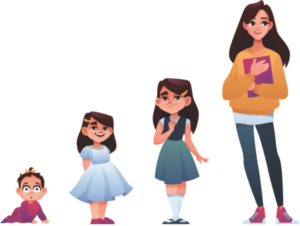Understanding Emotional Development
Attention Magazine December 2022
Strategies Parents Can Use from Toddlerhood through Adolescence
Emotions PROVIDE CHILDREN WITH INVALUABLE INFORMATION about themselves, their environment, and their relationship with others in their environment. Developing the ability to identify, understand, and integrate emotional information are critical aspects of emotion development, which when achieved are associated with positive social, academic, and mental health outcomes for children.

It is well established that children with ADHD have significant difficulties with emotional development, including more frequent shifts in and intensity of emotions, and difficulties regulating their emotions. Encouragingly, there is growing support for the critical role parents and caregivers can play in supporting the emotional development of children with ADHD.
Along with an overview of emotion development from toddlerhood through adolescence, this article offers strategies you can use to support your child’s emotional well-being in each developmental period.
Toddlerhood and preschool years (ages two to five)
A major aspect of emotional development during this developmental period is increasing emotional awareness—that is, identifying, differentiating, and labeling emotions in oneself and others. Children in the preschool years tend to express emotions in play and teasing. During toddlerhood, children begin to develop self-conscious emotions such as shame, embarrassment, and pride. Additionally, this is when they begin to understand that certain emotions are associated with particular situations; for example, being sad when a parent has to go away on a work trip for a couple days because they will miss them.
During the preschool years, children begin to develop rudimentary emotion regulation strategies to deal with difficult emotions, such as going to a parent for comfort. At this age, children often require support from others such as parents, teachers, or older siblings to help regulate their mood; however, they also can begin to talk themselves through emotionally challenging situations or distract themselves.
Strategies you can use during toddlerhood/the preschool years
- Label and talk to your child about emotions in yourself and others; for example, “Why do you think he is upset?” or “I feel so proud when I see you sharing your toys with your brother.”
- Encourage your child to name emotions they are experiencing. If they have difficulty with this, get a chart with various facial expressions and labels to increase your child’s ability to identify emotions. You can use this chart each day to have your child identify how they are feeling by pointing to the face that shows how they feel.
- When reading with your child or watching a show, label emotions or ask your child to label the emotions the characters are feeling based on facial expressions, body language, and contextual clues. Ask your child questions that extend the story, such as a time they felt the same emotion as the character. If they struggle with answering, help suggest a time they may have felt that way.
- To help deal with anger and fear, help young children avoid upsetting situations or, if such situations are unavoidable, use distraction to help them regulate their emotions. This provides an example for how they can manage these emotions by themselves as they grow older.
- Model adaptive emotion regulation strategies; for example, take a few deep breaths and speak calmly and firmly, rather than getting upset during your child’s meltdown. Children learn to manage their emotions by watching us!
Childhood (ages six to eleven)
During childhood, children begin to understand and differentiate when certain emotional expressions are appropriate and increasingly use social skills to manage the emotions of themselves and others. Additionally, during the early childhood years, children begin to understand that expressed emotions do not necessarily match one’s subjective experience, such as acting happy even if you feel disappointed by a birthday present you receive. Children also can recognize that their emotions in a particular situation may not be the same as others, and thus may choose to change their emotional expression.
Despite these gains in emotional understanding and awareness, many children still find it hard to express and regulate their emotions. However, children of this age are capable of identifying and using a range of strategies to regulate emotions and manage stress. Children often use avoidance or distancing to manage emotions, particularly in contexts when they have little control over the situation.
Parents can support emotion regulation development during childhood through modeling, problem-solving, and encouragement and/or prompting. Discussing negative situations after your child has had a chance to calm down and reflect can also help them better identify things they can do differently in the future.
Strategies you can use during the childhood years
- Encourage your child to name emotions they are experiencing—help them determine what made them feel that way, what they can do to feel better, reflect on how they handled their emotion, and if there is something they can do differently next time.
- Validate your child’s emotions and provide a supportive environment in which they feel safe to express their emotions with you. When your child comes to you with an emotional experience, try to give them your undivided attention by looking them in their eyes, repeating back what you are hearing they experienced, and reassuring them that you understand—that it is okay to feel this way.
- Model appropriate regulation; figure out what your coping strategies are and use them—take some space, go for a walk, take a deep breath, take a warm bath, listen to music, call a friend. Children exposed to more dysregulated negative emotions such as yelling, swearing, and getting physical are more likely to struggle in managing their own emotions.
- Help your child learn that they can modify the emotion they experience or at least the intensity of the emotion; try asking if their reaction matched the size of the problem.
- Encourage your child to delay their response and consider the likely consequences of their behaviors. Often delaying their reaction and helping them consider negative consequences leads to less intense behavior and fosters better problem solving.
- Help your child generate a list of coping strategies, that is, things they can do that help them feel better and that are not harmful to themselves or others. Provide prompts to encourage your child to use one of their coping strategies when they are experiencing a negative emotion.
Adolescence (ages twelve to seventeen)
Adolescence is a period of intense emotionality and emotion dysregulation; additionally, adolescents are more likely to use less adaptive (such as problem solving, distraction, acceptance, revaluation) and more maladaptive strategies (including aggression, giving up, rumination, withdrawal) to regulate their emotions. Despite this, adolescents experience large gains in their ability to regulate emotions independently, and begin to differentiate their strategies depending upon social-emotional context as well as motivation and emotion type.
In contrast to childhood, peers have a larger influence on adolescents, and adolescents tend to display and discuss emotions more with peers than parents. This shift occurs for a variety of reasons, including that friendships become more dyadic and intimate during adolescence, friends have equal power (relative to parent-adolescent relationships) resulting in friends being more likely to respond in friendly and/or supportive ways, friends having shared social experiences that lead to emotional disclosure, and using self-disclosure for intimacy and belongingness with peers. These developmental changes can lead to increased conflict among parents and adolescents, particularly if parents do not understand why these changes occur and shift their parenting strategies accordingly.
Strategies you can use during the adolescent years
 Validate your adolescent’s emotional experience, even if you do not understand or agree with the emotion they are experiencing. Separate the emotion from the behavior; for example, you can validate that it is upsetting that their best friend is mad at them while still making it clear that it is not okay to swear at their younger sister because they are upset.
Validate your adolescent’s emotional experience, even if you do not understand or agree with the emotion they are experiencing. Separate the emotion from the behavior; for example, you can validate that it is upsetting that their best friend is mad at them while still making it clear that it is not okay to swear at their younger sister because they are upset.- Don’t minimize your adolescent’s emotion; for example, saying “oh, you’re overreacting” or “you’re being so dramatic.” Such statements decrease your adolescent’s likelihood of feeling supported and thus their likelihood to disclose and discuss future emotional experiences.
- Don’t pressure your adolescent to talk about something at a particular time. Communicate that you are there if/when they want to talk. The more you can be supportive each time they choose to share an emotional experience with you on their terms, the more likely they will be to continue to do so.
- Ask your adolescent what would be helpful when they share an emotional experience; that is, do they just want to vent, do they want to problem solve, or do they just want to run an idea by you (and hopefully be validated/reassured).
- Guide your adolescent into recognizing that emotions are temporary even though they do not seem that way when we are intensely experiencing them.
- Support and encourage your adolescent to have other social supports besides you who they can talk to when they are experiencing negative emotions, such as a friend, an older sibling, a coach, or an extended family member like a cousin or aunt.


 Rosanna Breaux, PhD, LCP, is an assistant professor of psychology at Virginia Polytechnic Institute and State University in Blacksburg, Virginia. She is the assistant director of the Virginia Tech Child Study Center, a specialty research, service, and training facility devoted to the comprehensive assessment, treatment, prevention, and understanding of problems of childhood and adolescence. Dr. Breaux’s research focuses on the emotional and social functioning of children and adolescents with ADHD, with a focus on emotion regulation. Additionally, Dr. Breaux is working to evaluate and disseminate the RELAX intervention for adolescents with ADHD, which targets emotion dysregulation and interpersonal conflict.
Rosanna Breaux, PhD, LCP, is an assistant professor of psychology at Virginia Polytechnic Institute and State University in Blacksburg, Virginia. She is the assistant director of the Virginia Tech Child Study Center, a specialty research, service, and training facility devoted to the comprehensive assessment, treatment, prevention, and understanding of problems of childhood and adolescence. Dr. Breaux’s research focuses on the emotional and social functioning of children and adolescents with ADHD, with a focus on emotion regulation. Additionally, Dr. Breaux is working to evaluate and disseminate the RELAX intervention for adolescents with ADHD, which targets emotion dysregulation and interpersonal conflict.